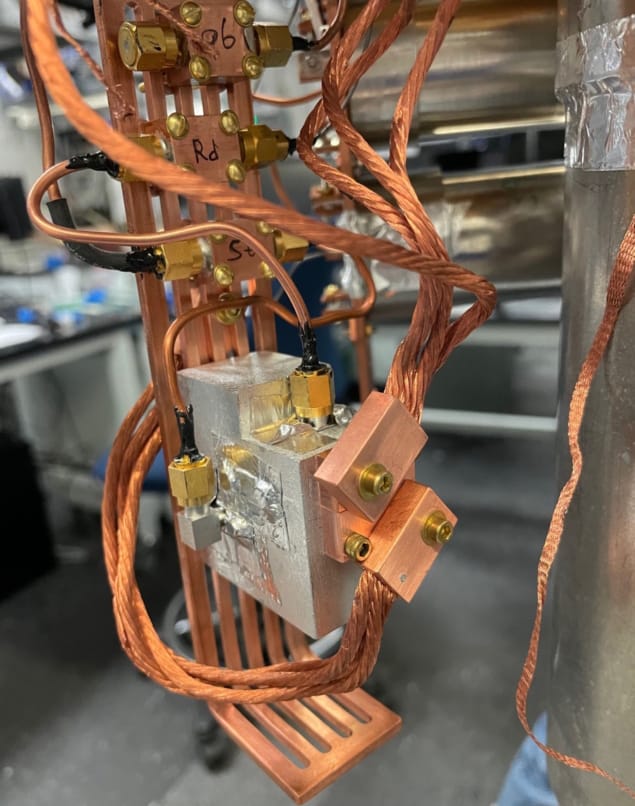Real-time error correction extends the lifetime of quantum information
29 Mar 2023 Naomi Solomons
Extended lifetime Quantum information is protected by encoding it in a more complicated system, such as the “GKP state”. (Courtesy: Volodymyr Sivak, Yale University)
A team of researchers at Yale University has been able to observe and correct errors in real time as they occur in a quantum system, preserving the information for over twice as long as it could otherwise be stored.
Quantum computing uses certain physical systems, such as superconducting circuits, atoms, ions or photons, to perform calculations that would be too difficult for classical computers. However, quantum states are delicate and susceptible to noise, making them difficult to maintain. Researchers have proposed various methods that correct these errors as they occur; however, all come with considerable hardware challenges.
Quantum information is usually stored as qubits, using quantum systems that can be in a “superposition” of two different states at the same time, such as a photon with two different polarization states. All error-correction schemes need to make use of extra information in the system, as this information is employed to notify the observer that errors have occurred and give details that are used to correct them. These schemes can make use of extra states in the same quantum system hosting the qubit, such as additional energy levels, or they can combine several qubits together.
Optimizing the experiment
The team, led by Michel Devoret, used the former method, employing a qubit encoding known as a GKP (Gottseman-Kitaev-Preskill) code. This was implemented using light confined in an aluminium cavity, connected to a sapphire chip with a superconducting qubit (known as a “transmon”). The cavity was used as the main system to store the quantum information, which was controlled by the transmon. Keep it cool This image shows copper braids that run between the dilution refrigerator, used to maintain the system at extremely low temperatures, and the clamp that holds the transmon in place. (Courtesy: Volodymyr Sivak, Yale University)
Keep it cool This image shows copper braids that run between the dilution refrigerator, used to maintain the system at extremely low temperatures, and the clamp that holds the transmon in place. (Courtesy: Volodymyr Sivak, Yale University)
 Keep it cool This image shows copper braids that run between the dilution refrigerator, used to maintain the system at extremely low temperatures, and the clamp that holds the transmon in place. (Courtesy: Volodymyr Sivak, Yale University)
Keep it cool This image shows copper braids that run between the dilution refrigerator, used to maintain the system at extremely low temperatures, and the clamp that holds the transmon in place. (Courtesy: Volodymyr Sivak, Yale University)In order to accurately assess the improvement gained by using error correction, the lifetime of the qubit had to be compared with the uncorrected lifetime of other potential qubits in the system. This could be either using the transmon itself, or using the cavity as a simple two-level system (instead of preparing the full GKP state), which had the longest lifetime of 800 µs. The extended lifetime of the GKP qubit measured after error correction was 1.82 ms, an improvement of 2.27 times.
Each cycle of measuring and correcting errors takes 10 µs, requiring state-of-the-art hardware. To optimize the experimental parameters, the team employed a machine-learning system to choose, for example, the average number of photons used when implementing operations.
A lower number of photons was chosen, which increases the time for these procedures, but reduces the probability of harder-to-correct errors. Optimization like this could be a valuable tool to deal with the complexity of future experiments when choosing parameters.READ MORE

As lead author Volodymyr Sivak, now a research scientist at Google, explains, “other experiments normally track the error, but do not intervene to correct it”. As an experimental demonstration that it is truly possible to extend the lifetime of a quantum state using error correction, this is a major milestone for quantum computing, according to Sivak, “to show that there is no fundamental obstacle to doing quantum error correction, that it is actually possible in the real world and not only on paper”.
Other error-correction schemes require many qubits, which need to pass a certain quality threshold before they can be combined to reduce the overall error. Future work could involve using a GKP qubit such as the one introduced in this work as a “base qubit” for these techniques, although as Sivak notes, this “will take some time”.
The research is described in Nature.

Naomi Solomons is a PhD student contributor to Physics World. Naomi is studying quantum engineering at the University of Bristol. Find out more about our student contributor networks
FROM PHYSICSWORLD.COM 20/4/2023

Δεν υπάρχουν σχόλια:
Δημοσίευση σχολίου